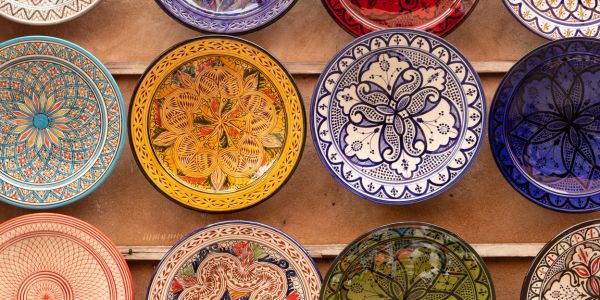Welcome to the world of creative home decor! If you’re looking to add a touch of elegance and uniqueness to your living space, hanging a heavy ceramic plate on your wall can be a fantastic choice. Whether it’s a hand-painted artisanal piece or a cherished heirloom, displaying ceramic plates can transform your walls into captivating art galleries. Let’s discover How to Hang a Heavy Ceramic Plate on Wall to di it ourself.
However, the process of securely hanging a heavy ceramic plate requires a bit of know-how and the right tools to ensure both the safety of your precious plate and the aesthetic appeal of your decor. In this guide, we’ll walk you through the step-by-step process of properly hanging a heavy ceramic plate on your wall, offering tips and insights to make your decorating endeavor a success. So, let’s dive in and learn how to showcase your ceramic masterpiece with confidence and style!
Can I hang a heavy ceramic plate on wall?

Yes, you can hang a heavy ceramic plate on a wall. However, it’s crucial to follow the proper steps to ensure the plate’s stability and prevent any damage to your wall or the plate itself. Using appropriate plate hangers or adhesive plate hangers, finding a secure attachment point on the plate, and using suitable wall anchors or hooks are essential for a successful installation.
Always consider the weight of the plate, the wall material, and follow the manufacturer’s guidelines for any hanging accessories. With the right tools and precautions, you can proudly display your heavy ceramic plate as a stunning piece of wall art.
Is it good idea to hang a ceramic plate on wall
Hanging a ceramic plate on a wall can be a great idea for adding a unique and artistic touch to your home decor. Ceramic plates come in various designs, colors, and patterns, making them visually appealing and suitable for enhancing the aesthetics of your living space.
However, it’s important to ensure that you follow proper hanging techniques to prevent any damage to the plate or the wall. Using appropriate plate hangers, wall anchors, and considering the weight of the plate are crucial factors to consider.
With proper precautions and the right tools, hanging a ceramic plate on the wall can be a beautiful and creative way to showcase your artistic taste.
How to hang a heavy ceramic plate on wall
Hanging a heavy ceramic plate on a wall requires careful consideration and the right tools to ensure both the plate’s safety and the wall’s integrity. Here’s a step-by-step guide to help you:
Choose the Right Plate:
Select a ceramic plate that you want to display. Keep in mind its weight, size, and design, as these factors will determine the type of hanger or method you should use.
Gather Supplies:
- Heavy-duty plate hanger or adhesive plate hanger (designed for heavy items)
- Measuring tape
- Pencil
- Wall anchors or heavy-duty hooks
- Level
- Screwdriver or drill (if needed)
Inspect the Plate:
Examine the back of the plate to identify areas where you can attach the hanger without damaging the design. Look for sturdy points like the plate’s rim or decorative elements that can bear the weight.
Attach the Plate Hanger:
- For Heavy-Duty Plate Hangers: Follow the manufacturer’s instructions to attach the hanger to the plate. These hangers usually have wires that gently clasp the plate’s rim and adjustable brackets for support.
- For Adhesive Plate Hangers: Clean the back of the plate thoroughly and attach the adhesive hanger according to the manufacturer’s guidelines. These hangers use adhesive pads to create a secure bond.
Mark the Wall:
Hold the plate against the wall at the desired height. Use a pencil to lightly mark the wall where the top of the plate will be.
Install Wall Anchors or Hooks:
- For Drywall: If your plate is heavy, use wall anchors to provide strong support. Drill holes for the anchors, insert them, and then attach heavy-duty hooks.
- For Studs: If possible, hang the plate on a wall stud using heavy-duty hooks or screws.
Hang the Plate:
- Gently hang the plate on the wall hooks or anchors. Check if it’s level using a level tool.
- Secure the Plate (Optional): If you’re concerned about the plate shifting, consider using clear adhesive putty or museum putty on the bottom of the plate to hold it in place.
Remember that the success of hanging a heavy ceramic plate relies on using appropriate hangers, anchors, and following the weight-bearing capacities of your wall and the chosen hanging hardware. Regularly inspect the plate and its attachments to ensure everything remains secure over time. With patience and care, your heavy ceramic plate can become a stunning focal point of your wall decor.
Safety tips while hang a ceramic plate on wall

When hanging a ceramic plate on a wall, safety is paramount to ensure both the plate and your living space remain intact. Here are some important safety tips to consider:
Choose the Right Hanging Hardware:
Opt for plate hangers specifically designed to support the weight of your ceramic plate. Heavy-duty plate hangers or adhesive plate hangers designed for heavy items are ideal.
Inspect the Plate:
Examine the ceramic plate for any cracks, chips, or weaknesses before hanging it. Hanging a damaged plate could lead to breakage and potential harm.
Check Wall Material:
Make sure your wall can support the weight of the plate. Different wall materials (drywall, plaster, brick, etc.) require specific types of anchors and hooks. Use appropriate hardware based on the wall material.
Use Wall Anchors:
If you’re hanging the plate on drywall, use wall anchors to distribute the weight and prevent damage. Choose wall anchors that can handle the weight of the plate.
Locate Studs:
If possible, hang the plate on a wall stud for added stability. Studs offer better support than just hanging on the drywall.
Follow Weight Limits:
Respect the weight limits of both the plate hanger and the wall hardware. If your plate is exceptionally heavy, consider using additional anchors or support.
Secure the Plate:
If you’re concerned about the plate shifting, use adhesive putty or museum putty on the bottom to prevent movement.
Leveling:
Ensure the plate is hung level using a level tool. A skewed plate could be a safety hazard and detract from the visual appeal.
Regular Inspection:
Periodically check the plate and its hanging hardware for any signs of wear or instability. Tighten any screws or attachments as needed.
Location Matters:
Avoid hanging the plate in areas prone to direct sunlight, humidity, or extreme temperature changes. These factors can affect the plate’s condition over time.
Clear Pathways:
Hang the plate in a location where it won’t accidentally bump into people or objects, reducing the risk of accidents.
Height Consideration:
Hang the plate at a height that’s safe for everyone, including children and pets. Avoid placing it too low, where it might be within reach of curious hands or paws.
Protective Measures:
Consider using clear, transparent bumpers on the back of the plate to prevent it from touching the wall directly and potentially causing friction-related damage.
By adhering to these safety tips, you can confidently display your heavy ceramic plate as a striking piece of wall art while ensuring the well-being of both the plate and your living environment.
Is Hanging ceramic plate increases beauty of wall?

Absolutely, hanging a ceramic plate on a wall can significantly enhance the beauty of your space. Ceramic plates come in a variety of designs, colors, and patterns, making them versatile decorative elements that can add character and charm to any room. Here’s how they can increase the beauty of your wall:
Unique Artistry:
Ceramic plates often feature intricate hand-painted designs, delicate details, and vibrant colors. Their artistic appeal can transform a plain wall into a visually captivating focal point.
Texture and Dimension:
Ceramic plates provide texture and dimension that go beyond flat artwork. The curves and contours of the plate’s surface can cast interesting shadows, creating depth and visual interest.
Color Palette:
You can choose plates that complement your existing color scheme or introduce new colors to liven up the room. A well-chosen plate can tie together various elements of your decor.
Cultural and Historical Significance:
Ceramic plates can carry cultural, historical, or sentimental value. Displaying them on the wall allows you to showcase these meaningful items as part of your home’s story.
Elevated Aesthetics:
Hanging a ceramic plate adds a touch of sophistication and elegance to your decor. It shows attention to detail and a commitment to creating a visually appealing living space.
Conversation Starter:
Guests will likely be intrigued by the unique choice of decor, prompting conversations about the plates, their origins, and your personal taste.
Versatility:
Ceramic plates can be arranged in various configurations. You can create a symmetrical arrangement, a gallery wall with multiple plates, or mix and match different sizes and designs for a dynamic look.
Mix of Materials:
The combination of ceramic with other materials, such as wood, metal, or glass, can create a pleasing contrast that adds depth and complexity to your wall display.
Customization:
With a collection of ceramic plates, you have the freedom to curate your own art gallery that’s tailored to your preferences and style.
Affordable Art:
Ceramic plates offer an accessible way to incorporate art into your space without the investment of traditional framed artwork.
FAQ’s of hanging ceramic plate on wall
What are the key considerations before attempting to hang a heavy ceramic plate on a wall?
A1: Before hanging a heavy ceramic plate, consider its weight, size, design, and the type of wall you have. These factors determine the appropriate hanging hardware and methods to ensure stability and safety.
What types of hanging hardware are suitable for heavy ceramic plates?
A2: For heavy ceramic plates, heavy-duty plate hangers or adhesive plate hangers designed for heavy items are recommended. These options provide secure support while minimizing the risk of damage.
How can I identify a suitable attachment point on the ceramic plate for hanging?
A3: Inspect the back of the plate to identify sturdy points like the rim or decorative elements that can bear the weight. Avoid fragile areas and consider the overall balance of the plate.
What’s the importance of choosing the right wall anchors or hooks?
A4: The wall anchors or hooks you choose should match the wall material and support the weight of the plate. Proper anchors distribute the weight evenly and prevent damage to the wall.
How can I ensure that the ceramic plate is hung securely and level on the wall?
A5: Use a level to ensure the plate is hung straight. Securely attach the plate to the chosen hardware and double-check its alignment before finalizing the installation.
Are there any additional measures I should take to prevent the plate from shifting or falling?
A6: Using adhesive putty or museum putty on the bottom of the plate can help prevent movement and keep the plate securely in place.
What safety precautions should I keep in mind when hanging a heavy ceramic plate?
A7: Ensure that the plate is in good condition without cracks or weaknesses. Use appropriate hanging hardware and wall anchors, follow weight limits, and periodically inspect the installation for stability.
Can I hang a heavy ceramic plate on any type of wall?
A8: Different wall materials have varying weight-bearing capacities. It’s important to choose the right wall anchors and hooks based on the type of wall you have, such as drywall, plaster, or brick.
What are the potential risks if I hang a heavy ceramic plate improperly?
A9: Improper hanging of a heavy ceramic plate can lead to wall damage, plate breakage, and potential accidents if the plate falls. It’s crucial to follow proper hanging techniques to mitigate these risks.
How can I incorporate the hanging of heavy ceramic plates into my overall interior decor scheme?
A10: Consider the design, color, and placement of the ceramic plate in relation to your existing decor. A well-chosen plate can enhance the aesthetics of your space and become a focal point of interest.
Conclusion
In conclusion, hanging a heavy ceramic plate on a wall is a rewarding endeavor that can elevate your interior decor and infuse your living space with artistic flair. By carefully considering the weight of the plate, selecting appropriate hanging hardware, and following the right steps, you can achieve both aesthetic appeal and safety.
Remember to inspect the plate, choose suitable attachment points, and adhere to the weight limits of your wall and hardware. Taking the time to align the plate accurately and periodically checking its stability ensures a secure display.
With patience, attention to detail, and adherence to safety measures, you can transform your wall into a gallery of captivating ceramic art that reflects your unique style and taste.
What should i need to hang ceramic plate on wall?
To hang a ceramic plate on a wall securely and effectively, you’ll need a few essential tools and materials. Here’s a list of what you’ll need:
- Ceramic Plate: Choose the ceramic plate you want to hang, considering its weight, size, and design.
- Plate Hanger: Select an appropriate plate hanger based on the weight of the plate. Opt for heavy-duty plate hangers or adhesive plate hangers designed for heavy items.
- Measuring Tape: Use a measuring tape to determine the desired height and placement of the plate on the wall.
- Pencil: A pencil will help you mark the wall where you intend to hang the plate.
- Wall Anchors: Depending on your wall type (drywall, plaster, brick), choose suitable wall anchors to support the weight of the plate. Wall anchors distribute the weight and prevent damage to the wall.
- Heavy-Duty Hooks: If your wall requires hooks, select heavy-duty hooks that match the weight of the plate. These hooks will provide a secure attachment point for the plate hanger.
- Level: A level tool ensures that the plate is hung straight and aligned properly on the wall.
- Screwdriver or Drill: A screwdriver or drill may be necessary to install wall anchors and hooks, especially if you’re dealing with harder wall materials.
- Adhesive Putty (Optional): Clear adhesive putty or museum putty can be used to secure the plate in place and prevent movement.
- Transparent Bumpers (Optional): These can be attached to the back of the plate to protect both the plate and the wall from potential damage caused by friction.
- Protective Gloves (Optional): If handling heavy plates or using tools, wearing protective gloves can prevent injuries.